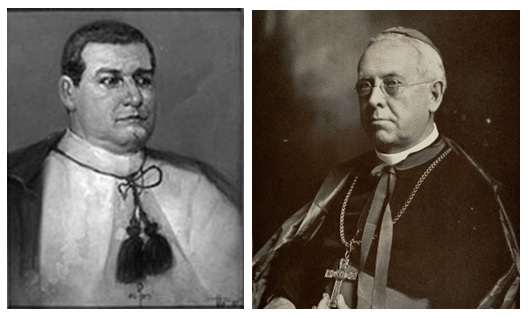
At left is Spanish Dominican Bernardino Villa Nozaleda, OP, who was Manila archbishop from 1889 until his resignation in 1902. He was replaced by American Jesuit Jeremiah James Harty SJ, who served as Manila archbishop from 1903 to 1916. PHOTO FROM WIKIPEDIA
The first and the last Spanish bishop of Manila were Dominicans. Domingo de Salazar, installed in 1581, was the first and Bernardino Nozaleda was the last, who was installed in 1890 until his resignation in 1902.
Bishop Salazar was the first prelate put in charge of the entire archipelago of more than 7,000 islands at a time that Leonardo da Vinci’s airplane design was still on the drawing board, the existence of places outside Europe was still gossip and straits, seas and strange lands have not been mapped.
The Vatican read the signs of the times, the turmoil at the end of the 19th century, and required the resignation of Afrchbishop Nozaleda in 1902, carving a place for Fr. Jeremiah J. Harty, who was then an unknown parish priest of St. Leo Parish in Missouri.
With the change of colonial masters, the shortlisting was done directly by the Vatican. At the turn of the century, the Vatican needed a shortlist of qualified clergy for the four dioceses of Manila, Nueva Segovia, Cebu, and Jaro, which were soon to be declared sede vacante with the exit of the last Spanish bishops.
Again, no Filipino was considered for the key episcopate. If Padres Pedro Peláez (1812-1863), José Burgos (1837-1872), who fought hard for the gradual Filipinization of the parishes, were alive, they could have protested: Why choose an ordinary parish priest of a small city in Missouri to replace the outgoing archbishop of Manila, when that parish priest was not even a vicar general of his diocese?
Last four Spanish bishops replaced
On June 10, 1903, Pope Leo XIII chose Jeremiah J. Harty to replace Archbishop Nozaleda of Manila, Frederick Rooker in place of Bishop Andres Ferrero of Jaro, Thomas A. Hendrick in place of Bishop Martin Acocer of Cebu and Dennis Dougherty in place of Bishop Campomanes of Nueva Segovia.
The appointment of the four American bishops swept aside a shortlist of equally qualified Filipino priests.
The first Filipino bishop ever appointed, Bicolano Jorge Imperial Barlin, was designated bishop of Nueva Caceres and consecrated only in 1906. Only in 1909 was the second Filipino bishop, Juan Bautista Gorordo (1862-1934) , ordained as auxiliary bishop of Cebu. The third was Pablo Singzon (1851-1920), the first bishop of Calbayog, who was made bishop in 1910.
Was it because the near-effortless “mock and phony” victory of the Americans against the Spanish armada in Manila Bay in May 1898 signaled the beginning of the 48-year American colonial administration in the Philippines, and with it the choice of American prelates over Filipinos? Or because the American prelates were considered more effective in both diplomatic and managerial tasks for the new colonial masters than Filipino prelates?
Probable reasons for Vatican decisions
By the turn of the century, the native secular clergy was made to choose between the patriotic cause of the new Filipino Independent Church, or Aglipayanism, and loyalty to the Pope. Confusion ruled the dioceses across the nation. The seminaries and Catholic schools were left lethargic, and parishes left without a point-person.
Further, the abolition of the Patronato Real had caused more financial and logistics problems, as hospitals, schools, and parishes once administered jointly by the Spanish government and the Church were claimed by the Aglipayan clergy.
The strong anti-friar sentiment divided the Catholic faithful, while the American Thomasites and Protestant ministers were aggressively proselytizing them. More trouble and real problems continued to wreak havoc on the Barque of Peter in the Philippines like tidal waves.
One thing is pretty sure: The Americans were missionary bishops in the pastoral sense and they knew beforehand that their missionary assignments in the Philippines were difficult and drew migraines and headaches.
Added to this, they knew they were disadvantaged by their ignorance of the Filipino and Spanish languages in the most challenging transition period. However, lest we forget, the brave and pioneering American prelates accepted the appointments in obedience and traveled tens of kilometers across the Pacific to do the job.
(Jose Mario Bautista Maximiano, PHd, is lead convenor of Love Our Pope Movement and author of ‘Church Reforms–Semper Purificanda’ Volume 1.)

